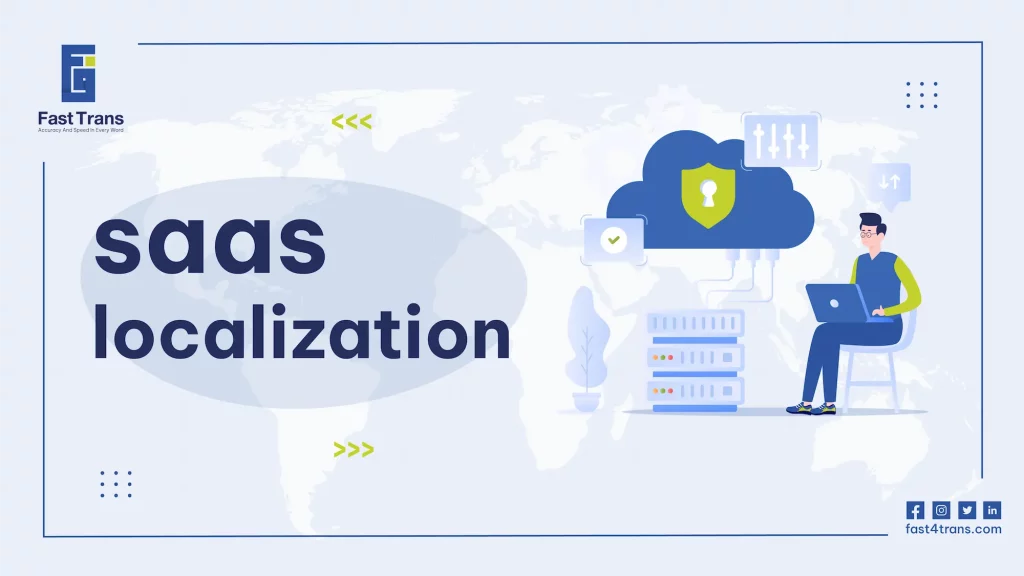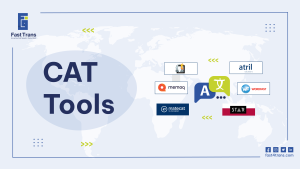Arabic SaaS localization tailors software to fit the cultural, linguistic, and legal needs of Arabic-speaking users. It goes beyond translation, adjusting the interface, payment methods, and user experience to align with local preferences, such as right-to-left text, regional currencies, and relevant design.
This process boosts accessibility, customer trust, and market reach, allowing businesses to better connect with users in Arabic-speaking regions while enhancing their overall brand presence and success.
What is the meaning of an Arabic SaaS localization?
First of all, it is important to understand the term “software as a service,” or “SaaS,” which refers to a SaaS model that uses a virtual cloud to host various services and applications, making them more easily and conveniently accessible to users through internet browsers.
Software as a Service (SaaS) is distinguished by its extremely flexible pricing structure, which allows you to pay for the services you use rather than having to pay full membership fees for capabilities you do not need. This makes SaaS a practical choice for customers.
The process of customizing SaaS to fit the target market’s language, culture, preferences, systems, and laws is known as SaaS localization services. In the case of Arabic SaaS localization, this process involves tailoring the service to meet the linguistic, cultural, and legal needs of Arabic-speaking users. This goes beyond simply translating the texts found in these programs; to make the user experience more effective and unique, an in-depth understanding of the Arabic-speaking market’s requirements is necessary.
A few things to consider while Arabic localizing SAAS
When Arabic localizing SAAS (Software as a Service), the localization process takes into account sociological and cultural sensitivities, user interface design features, and other factors specific to Arabic-speaking regions.
The solutions that the translation team focuses on customizing for the Arabic-speaking user culture include the following:
- SAAS design elements such as font type, colors, graphics, menus, buttons, and others, ensuring compatibility with Arabic script and right-to-left (RTL) layout.
- The written content of the program that the user interacts with regularly, including adjusting text for proper cultural context and nuances specific to Arabic-speaking users.
- Legal information related to the terms of use and data privacy, adapting them to the legal requirements and regulations governing digital services in the target Arabic-speaking country.
- Data formats such as Hijri (Islamic) calendar, as well as how to express numbers, currencies, and date formats in a way that resonates with the Arabic-speaking audience.
- Localizing the most relevant information about the material that the user experiences when using the application, from the initial interaction with the services to the decision to make a purchase, ensuring it aligns with local practices and preferences.
- Payment and pricing strategies that are in line with the target community’s typical earnings, local payment methods, and expectations for financial transactions.
- Other options for customer support and post-purchase services, including localized contact methods and culturally appropriate customer service approaches in Arabic.
- The speed of internet services in the target country, which affects the file size and loading time of the page. The page design and content display should be optimized for the average internet speed in Arabic-speaking regions.
Read more: Localization glossary
Benefits of the Arabic SaaS localization process
The process of Arabic SaaS localization brings many benefits to companies and organizations, the most prominent of which are the following:
- Eliminating language and cultural barriers and getting closer to customers in Arabic-speaking communities, which increases the company’s success in new markets across the Arab world.
- Localization helps improve the customer experience while interacting with your SaaS product in Arabic, encouraging users to spend more time using your platform and thus boosting brand awareness and increasing demand for your products.
- Enhance your brand image among the Arabic-speaking audience, as people tend to trust applications that communicate with them in their native language more than others, giving you a competitive marketing edge.
- If the expansion process is done effectively, it can be achieved with minimal financial costs. This approach helps the company increase its revenues by successfully tapping into the Arabic-speaking markets.
read more: What is Software internationalization and what to consider
Types of Arabic SaaS localization
Arabic SaaS localization involves adapting language elements, pricing, payment methods, features, user experience, and visuals to suit the specific cultural and regional preferences of Arabic-speaking users. Key factors include right-to-left script, local currencies, and region-specific functionalities to improve accessibility and relevance.
1. Localization of language elements
Since the language elements in the SaaS system are fully localized, starting from the application navigation menus, explanatory tools, and others, every aspect of the SaaS will be localized into Arabic to make the user experience more accessible. Special attention is needed for the Arabic language’s unique right-to-left script and cultural expressions to ensure clarity and relevance for Arabic-speaking users.
2. Localization of the price page
The price page is one of the most visited pages on any website, and its characteristics must be localized in proportion to the target Arabic-speaking market. This could include adjusting pricing formats, local currencies (such as the Saudi Riyal or Egyptian Pound), and aligning with regional pricing expectations to increase your product’s reach in new Arabic-speaking countries.
3. Localization of payment methods
Payment systems vary significantly across countries. While some methods are globally popular, others may be unique to specific regions due to social, political, or economic factors. In the case of Arabic SaaS localization, it’s essential to incorporate local payment methods such as Mada in Saudi Arabia or Fawry in Egypt, along with global options, to enhance the user experience for Arabic-speaking customers.
4. Customize features according to the target audience
To meet the needs of the Arabic-speaking audience throughout the localization process, you might occasionally need to add features or remove others that could make their experience more seamless and relevant. For example, incorporating region-specific functionalities, such as Arabic calendar support or local tax calculations, can improve user satisfaction.
5. User experience localization
The user experience can be made more accessible by localizing it for Arabic speakers, ensuring that they can navigate the application with ease. Factors such as the Arabic language’s right-to-left script, preferred layout styles, and cultural nuances must be considered. Additionally, understanding regional habits and user preferences plays a crucial role in ensuring the application feels intuitive and natural to Arabic users.
6. Localization of symbols and visual media
One of the most important aspects of Arabic SaaS localization is the localization of symbols, images, and tags used on pages. Some symbols may be culturally appropriate in one community but could hold a negative or inappropriate meaning in another. For Arabic localization, it’s vital to review visuals to ensure that they align with local values and avoid cultural missteps, ensuring the symbols and images are universally accepted in Arabic-speaking countries.
Read more about: 7 Arabic SaaS Localization Mistakes to Avoid
Common mistakes happen during Arabic SaaS localization
Common mistakes in Arabic SaaS localization include failing to define terms consistently for SEO and overlooking cultural nuances, user behaviors, and ongoing updates. Without a clear strategy or proper localization tools, these errors can hinder growth and lead to inefficient, costly efforts.
1. Start without a clear strategy
When it comes to localizing SaaS for the Arabic-speaking market, many corporate departments and organizations make the mistake of not planning in an organized way because they don’t have enough knowledge about the scope of their growth in international markets, particularly the Arab world.
Targeting this market requires careful consideration, as Arabic localization is a complex and costly process. Without a clear strategy, you risk wasting resources, time, and effort with no tangible return. It’s essential to base your decision on precise and transparent data that shows whether or not entering the Arabic market is viable.
2. Absence of preparations for ongoing upgrades
Many people think that the SaaS localization process for Arabic-speaking audiences is a one-time task, but the truth is quite the opposite. Arabic localization is an ongoing process that evolves as your services or products develop, and as the needs of the target market change.
In the Arab world, technology adoption and cultural trends shift quickly, so it’s important to be ready to make periodic updates to ensure your product remains relevant and useful. This includes reviewing and adapting all content as your SaaS grows in the region.
3. Neglect the actions of local users
User behavior is heavily influenced by the cultural values, customs, and traditions of the Arabic-speaking community. These values vary greatly between different Arabic-speaking countries, and neglecting to consider these differences can result in a user experience that falls short of expectations.
While it’s challenging to account for all local behaviors, understanding regional differences (such as preferences for formal language or design elements) is crucial for effective SaaS localization.
4. Paying attention to the stages of the consumer’s journey
Throughout their journey, Arabic users interact with SaaS features in a variety of ways. Some of these interactions might not be immediately obvious, but they are still important and should be taken into account during localization.
From signing up to receiving notifications, each step in the customer journey influences the overall user experience. Even the smallest details, such as the wording of prompts or the language used in notifications, can create a psychological connection between your SaaS and its Arabic-speaking users.
5. Issues with the overall formatting of the page
One of the most significant issues in Arabic SaaS localization is the formatting of the page. For instance, when translating English to Arabic, you might find that the text expands, causing layout problems. This is especially visible in menus and buttons, where the Arabic text may overflow or distort the design.
Another challenge is the direction of the text. Arabic is written from right to left (RTL), which can affect how UI elements are arranged. Often, this requires a complete redesign of the user interface to ensure that the content flows smoothly and that the layout is visually appealing for Arabic speakers.
6. Adding text to images and videos
In Arabic localization, it is crucial to use text in images and videos with caution. Direct translation of text in visuals can be tricky, as Arabic text may require more space or affect the overall design. A better practice is to add separate, localized text in captions or descriptions instead of embedding it directly in images or videos.
This method allows for easier adjustments without the need to create new visual assets for each language version.
7. Finishing the several localization phases manually
The SaaS localization process for Arabic is complex and involves multiple stages, including translation, design, and testing. Relying solely on manual processes can result in errors, inefficiencies, and delays. To ensure accuracy and speed up the workflow, it’s crucial to invest in specialized tools designed for SaaS localization early on.
This will help you automate repetitive tasks and ensure that the localization process is completed accurately and efficiently, saving both time and effort.
What are the Arabic SaaS localization steps?
The Arabic SaaS localization process involves researching the target market, adapting the product to local preferences (including language, culture, and payment methods), and ensuring SEO optimization. Continuous feedback, community-building, and culturally tailored marketing strategies are key to long-term success.
1. Conducting Target Market Research
Before beginning the localization process, it is essential to conduct thorough research into the Arabic-speaking target market, including geographical, cultural, legal, and other factors. Understanding these aspects will guide your decisions and help you adapt your SaaS offering to align with regional expectations and needs.
What may work well in one Arabic-speaking country may not be suitable in another, so it’s crucial to familiarize yourself with the various local characteristics before proceeding with localization.
2. Identify the Target Audience
To achieve the best results from the localization process, you need to clearly define the characteristics of your target audience. Understanding their preferences, language nuances, and specific needs will allow you to tailor your content and features to resonate with them.
This enables you to solve their pain points effectively and outperform competitors in the region, ultimately driving customer satisfaction.
3. Validate Your Virtual and Actual Presence
It’s important to establish a strong presence in the Arabic-speaking market, both virtually and physically. Ensure that your website and application are optimized for Arabic language and SEO to improve visibility. Additionally, if your business can have a physical office in the region, this boosts credibility.
A combination of online presence and local recognition will enhance brand awareness and attract potential customers.
4. Adapting the SaaS to Suit the Arabic Community
At this stage, the first steps of SaaS localization for Arabic-speaking users begin. This includes adapting the user interface (UI) to support the Arabic language (which reads right to left), choosing culturally appropriate visual elements, adjusting pricing and currency, and offering locally accepted payment methods.
Customizing these features to suit the culture of the target Arabic community enhances the user experience and encourages consistent engagement with your product.
5. Trial Launch and Testing
Before fully launching your localized SaaS product in the Arabic market, conducting a trial launch is crucial. This allows you to gather feedback from a select group of Arabic-speaking users to identify any issues or areas for improvement.
Testing helps ensure that the Arabic version of your product meets the needs of your audience and is free of any culturally insensitive or technical errors.
6. Building a Community from the Target Audience
Creating a team of local Arabic-speaking users who understand the culture and can respond to inquiries in their native language is a key step in the SaaS localization process.
This team will also provide valuable insights into the content, ensuring it aligns with the community’s customs, traditions, and preferences. A community of local users can also help spread positive word-of-mouth and foster engagement with your SaaS product.
7. Development of a Marketing Strategy
To effectively promote your SaaS product in the Arabic market, develop a marketing strategy that leverages Arabic social media platforms, engages with local influencers, and tailors advertisements to suit the cultural nuances of the region.
A culturally-aware marketing approach will play a significant role in attracting the right audience and ensuring your product’s success in the Arabic-speaking world.
8. Continuous Observation and Improvement
Even after the initial launch, ongoing monitoring of your localized SaaS product is essential. Continuously assess your services to identify weaknesses, address customer feedback, and make necessary improvements. Additionally, stay alert to new trends and creative opportunities to expand your reach, enhance your reputation, and increase revenue in the Arabic market.
Read more: why should localize your digital marketing campaign
How does fast-trans help with Arabic SaaS localization?
Since translating SAAS is a difficult process, we at Fast Trans certified translation companies, are committed to supporting you in reaching your objectives. We understand that the ultimate aim of SAAS localization services is to produce a SAAS product that is identical to the original when it is released to the target market.
All of this will be made possible with the assistance of our qualified staff, who are eager to offer translation and localization services with the highest standards of precision and quality, at the right time and at affordable rates, to help you enter new markets and gain recognition across the world.
Conclusion
Arabic SaaS localization is the process of adapting software services for Arabic-speaking audiences by adjusting the content, interface, and features to meet local cultural, linguistic, and legal needs. This involves more than just translating text; it requires understanding the nuances of the Arabic market, including right-to-left language support, culturally relevant design elements, local payment methods, and region-specific functionalities. By focusing on the unique preferences and expectations of Arabic users, businesses can offer a more intuitive and engaging user experience, making their platform more accessible and effective.
Localization also includes optimizing SEO for the Arabic market, ensuring that the platform is discoverable and resonates with local audiences. This process helps businesses break down language and cultural barriers, improving customer satisfaction and increasing the chances of success in Arabic-speaking regions. By addressing local legal requirements, adapting payment structures, and ensuring the service aligns with the expectations of Arabic consumers, companies can enhance their market presence, build trust, and expand their customer base across the Arab world.











